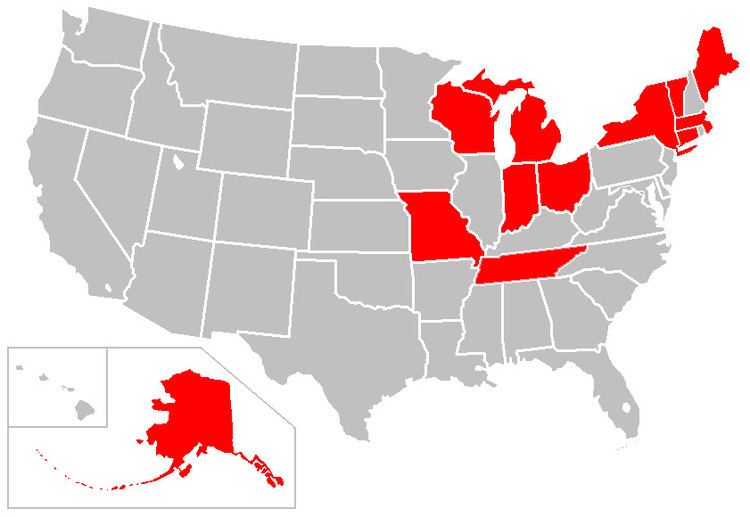 | ||
A cryoseism, also known as an ice quake or a frost quake, is a seismic event that may be caused by a sudden cracking action in frozen soil or rock saturated with water or ice. As water drains into the ground, it may eventually freeze and expand under colder temperatures, putting stress on its surroundings. This stress builds up until relieved explosively in the form of a cryoseism.
Contents
Another type of cryoseism is a non-tectonic seismic event caused by sudden glacial movements. This movement has been attributed to a veneer of water which may pool underneath a glacier sourced from surface ice melt. Hydraulic pressure of the liquid can act as a lubricant, allowing the glacier to suddenly shift position. This type of cryoseism can be very brief, or may last for several minutes.
The requirements for a cryoseism to occur are numerous; therefore, accurate predictions are not entirely possible and may constitute a factor in structural design and engineering when constructing in an area historically known for such events. Speculation has been made between global warming and the frequency of cryoseisms.
Effects
Cryoseisms are often mistaken for minor intraplate earthquakes. Initial indications may appear similar to those of an earthquake with tremors, vibrations, ground cracking and related noises, such as thundering or booming sounds. Cryoseisms can, however, be distinguished from earthquakes through meteorological and geological conditions. Cryoseisms can have an intensity of up to VI on the Modified Mercalli Scale. Furthermore, cryoseisms often exhibit high intensity in a very localized area, in the immediate proximity of the epicenter, as compared to the widespread effects of an earthquake. Due to lower-frequency vibrations of cryoseisms, some seismic monitoring stations may not record their occurrence. Although cryoseisms release less energy than most tectonic events, they can still cause damage or significant changes to an affected area.
Some reports have indicated the presence of "distant flashing lights" before or during a cryoseism, possibly because of electrical changes when rocks are compressed. Cracks and fissures may also appear as surface areas contract and split apart from the cold. The sometime superficial to moderate occurrences may range from a few centimeters to several kilometers long, with either singular or multiple linear fracturing and vertical or lateral displacement possible.
Location
Geocryological processes were identified as a possible cause of tremors as early as 1818. In the United States, such events have been reported throughout the Midwestern, Northern and Northeastern United States.
Cryoseisms also occur in Canada, especially along the Great Lakes/St. Lawrence corridor, where winter temperatures can shift very rapidly. They have surfaced in Ontario, Quebec and the Maritime Provinces. They are also observed in Calgary.
Glacier-related cryoseism phenomena have been reported in Alaska, Greenland, Iceland (Grímsvötn)., Ross Island, and the Antarctic Prince Charles Mountains.
Reports
Southern Ontario experienced numerous, albeit unverified, frost quakes on December 24, 2013, and more severe, waking a great many from sleep, on December 30, 2013 at 3:00 AM and later at 7:00 AM, as a result of the 2013 Central and Eastern Canada ice storm. The towns of Cornwall, Middlebury, Ripton, and Weybridge, Vermont experienced the same phenomenon after the same weather conditions with the loudest occurring around 4:50am on December 25. Essex County in New York experienced cryoseisms as late as December 31, 2013. Numerous frost quakes again occurred in the Greater Toronto Area around 2:00 AM January 3, 2014, and January 7, 2014 overnight. Many cryoseisms were also reported near Lac-Mégantic, in the Eastern Townships (Québec, Canada), in the last days of December 2013. Overall, there were over 2000 reports in Canada and over 260 in the United States of possible frostquakes from January to February of 2014. Most of these reports came from Greater Toronto Area and around Green Lake, Wisconsin area.
On March 4, 2014 the city of Calgary experienced a loud sound at 5:00 PM and many people are attributing this to cryoseism.
The West Island of Montreal experienced an ice quake at approximately 2:30 AM EST on January 6, 2015.
Wichita, Kansas reportedly experienced a loud boom on Saturday, January 17, 2016. It was the first recorded ice quake in Kansas.
During a January 2016 record cold spell several unusual loud bangs and tremors were reported around Finland, which has a very low baseline of seismological activity. One of the events was registered seismologically and deemed to be a frost quake.
February 9th, 2017 - Barrie to Penetanguishene, ON area reporting this phenomenon.
Precursors
There are four main precursors for a frost quake cryoseism event to occur: (1) a region must be susceptible to cold air masses, (2) the ground must undergo saturation from thaw or liquid precipitation prior to an intruding cold air mass, (3) most frost quakes are associated with minor snow cover on the ground without a significant amount of snow to insulate the ground (i.e., less than 6 inches), and (4) a rapid temperature drop from approximately freezing to near or below zero degrees Fahrenheit, which ordinarily occurred on a timescale of 16 to 48 hours.
Cryoseisms typically occur when temperatures rapidly decrease from above freezing to subzero, and are more than likely to occur between midnight and dawn (during the coldest parts of night). [However, due to the permanent nature of glacial ice, glacier-related cryoseisms may also occur in the warmer months of summer.] In general, cryoseisms may occur 3 to 4 hours after significant changes in temperature. Perennial or seasonal frost conditions involved with cryoseisms limit these events to temperate climates that experience seasonal variation with subzero winters. Additionally, the ground must be saturated with water, which can be caused by snowmelt, rain, sleet or flooding. Geologically, areas of permeable materials like sand or gravel, which are susceptible to frost action, are likelier candidates for cryoseisms. Following large cryoseisms, little to no seismic activity will be detected for several hours, indicating that accumulated stress has been relieved.
